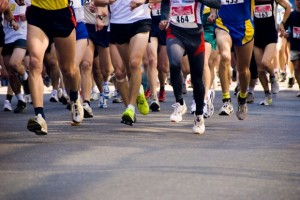 Whether your just starting out or you’ve been running for years… injuries don’t have to be part of life. Below are a few of the most common running injuries and how to avoid them.
Whether your just starting out or you’ve been running for years… injuries don’t have to be part of life. Below are a few of the most common running injuries and how to avoid them.
Runner’s Knee:
Patellofemoral pain syndrome (PFPS) or “runner’s knee,” is an irritation of the cartilage on the underside of the patella (kneecap). Runners knee can happen if you suffer from excessive inward foot rolling, (Overpronation ) over-training, and if you have weak quads, hips, or glutes.
The repetitive force of running on pavement, downhill running, or weak hips can put extra stress on the patella. To reduce the risk of patellar tendinitis, strengthen the hamstrings and quads. Change your running route, and stick to flat terrain, and opt for a softer running surface and shorten the length of time you’re training. To treat the pain, you can try knee taping, icing, anti-inflammatory medications, and Physiotherapy to help soothe and strengthen the tendon.
Achilles Tendinitis:
The Achilles tendon connects the two major calf muscles to the back of the heel. Under stress the tendon tightens and becomes irritated. Achilles Tendinitis can occur if you dramatically increase training or wear tight, improper footwear or have weak calves.
To help prevent Achilles Tendinitis always stretch the calf muscles post-workout, and wear supportive shoes. Stick to flat terrain as climbing hills puts extra stress on tendons. To treat the pain, you can use anti-inflammatories, stretching, the R.I.C.E strategy (rest, ice, compression, and elevation) and chiropractic and physiotherapy.
Plantar Fasciitis:
Plantar fasciitis are small tears or inflammation of the tendons and ligaments that run from your heel to your toes, Runners with high or very low arches can be vulnerable. Other causes are extreme pronation (foot rolls inward) or supination (foot rolls outward) and wearing unsupportive footwear. Try wearing runners that have extra support and extra cushion, start wearing custom orthotics and try stretching and rolling a tennis ball over the heel.
Shinsplints:
Shinsplints refers to medial tibial stress syndrome; shin splints occur when the muscles and tendons covering the shinbone become inflamed, or small tears occur in the muscles around your tibia (shin bone).
Shinsplints can occur by wearing the wrong runners or old runners. Make sure that your runners are the correct size and shape for your arch and foot and try to run on softer terrain whenever possible. To treat the pain, you can use anti-inflammatories, the R.I.C.E strategy (rest, ice, compression, and elevation) and chiropractic and physiotherapy.
IT Band Syndrome:
Your iliotibial (IT) band is a tendon that connects your knee to your hip. IT band syndrome (ITBS) results when this tendon becomes inflamed. IT Band Syndrome can be caused by downhill running, always running on the same side of the road and having weak hips.
To treat the pain, you can use anti-inflammatories, the R.I.C.E strategy (rest, ice, compression, and elevation) chiropractic, physiotherapy and foam rolling to help reduce pain.
Ankle sprain:
A sprain occurs when the ankle rolls in or outward, stretching the ligament. The most common culprits are curbs, potholes, and tree roots. Aim for several days of rest after a sprain occurs; how long depends on the sprain’s severity, so see your health care practitioner. You can also try taping the ankle to prevent re-twisting.
Pulled muscles:
When a muscle is overstretched, fibers and tendons can tear and cause a pulled muscle. Overuse and no warm-up stretches are a few preventable reasons why you would suffer from a pulled muscle. Make sure to include a proper warm-up, cool-down, and dynamic stretching pre-workout to avoid a pulled muscle.
To minimize the aches and pains, consider these tips to help keep you injury free:
Don’t increase the mileage by more than 10 percent each week. Upping your distance unexpectedly is the main reason why overuse injuries occur!
Remember to incorporate warm up and cool down exercises into each run to prepare the body for the activity that’s about to start.
Make sure to use correct running form/technqie so that your body is smooth and effieicent as you run. Imbalances in your body mechanics can lead to problems later on.
Keep track of how many kilometers you are running and replace your runners every 400 kilometers.
Avoid running on uneven surfaces that put unnecessary stress on ligaments.
Strength train can increase structural fitness which helps bones, ligaments, tendons, and muscles endure all that running.
Make sure to schedule and take at least one rest day off per week and at least one lighter activity day per week.
Having a training plan will keep you on track to meet your goals, and ensure that you build up your workout time gradually enough that you don’t get injured.


